|
- Catalog (in stock)
- Back-Catalog
- Mail Order
- Online Order
- Sounds
- Instruments
- Projects
- History Face
- ten years 87-97
- Review Face
- our friends
- Albis Face
- Albis - Photos
- Albis Work
- Links
- Home
- Contact
- Profil YouTube
- Overton Network
P & C December 1998
- Face Music / Albi
- last update 03-2016
|
You may produce rhythm by clapping with your hands, and you produce sound by blowing air across them.
There are a variety of hard-blown and soft-blown wind instruments. Air is blown into a mouthpiece, therewith producing a vibration generating a sound, without the use of lips. This method is applied in connection with the mouthpiece of the trumpet. Such instruments are made from clay, wood or animal’s horn, today there is only naturally also used metal or plastics. Some are used as children’s toys or in rituals.
The various tribes in Uganda also use stringed instruments, on which there are played improvisational pieces and which may be used for the accompaniment of texts. These strings can be made by spinning or twisting sisal, skin-strips or fiber-tissues. Instruments which have these strings fastened in different ways to different shapes of frames are picked, plucked, strummed, hit or struck. Some of them are so temporary that they are not on our list, such as, for example, this one: a string held on one end by biting with the teeth and pulled on the other, while the right hand plucks it or gives finger strokes to it. Different notes can be played by releasing and tensing the string accordingly.
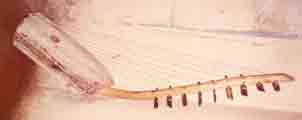
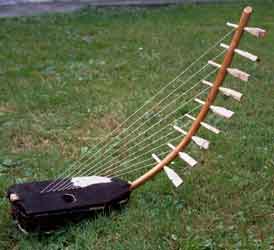 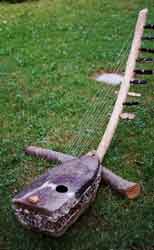
|
- Adungu, Adeudeu
bow harp - arched harp - string instument
The eight-stringed ennanga of the Buganda and the six-stringed adeudeu (bow-harp) of the Iteso people are similar in shape with the eight or more stringed adungu from the western Nile region.
The adungu is a nine-string arched (bow) harp of the Alur people of northwestern Uganda. It is very similar to the tumi harp of the neighbouring Kebu people, and it is also used by the Lugbara and Ondrosi tribes in this northwestern region around the Nile. The harp is used to accompany epic and lyrical songs, and it is also used as a solo instrument or within ensembles. Players of arched harps have had a high social status and are included in royal retinues. Nowadays they also play in churches.
The adungu consists of an arched neck, a wooden resonator (sound box) in which the neck is fixed, and a series of parallel strings of unequal lengths that are plucked. The strings are fixed at one end to the resonator and run at an oblique angle to the neck, where they are attached and tuned with pegs.
The first, second, and third strings are tuned in octaves with the sixth, seventh, and eighth respectively. In traditional music the instrument is tuned in a pentatonic (five-note) scale, but it can also be tuned in modern style to a diatonic scale.
|
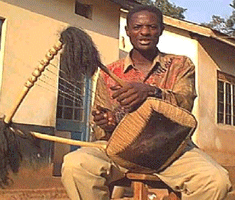
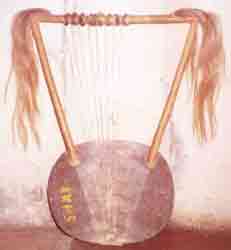
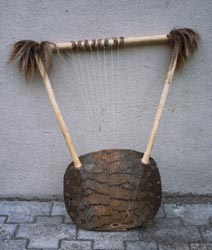
|
- Endongo - Entongoli
lyre - bowl lyre - harp lute - kora - string instrument
Baganda people sometimes called it endongo when they played to lead a wedding dance, (embaga). In eastern Uganda a similar instrument is called litungu. The Bagishu used it for the shoulder dance and called it kamabega.
This is the most representative instrument of the Baganda and Basoga. Generally, the harp-lute is the instrument of the griots, or praise-singers, much as the similar kora or soron is among the people of Guinea, Ivory Coast, Senegal, Gambia, and southern Mali. It is played either solo or to accompany songs of praise. The endongo has six to eight strings which are plucked. However, the instrument's structure differs significantly from the harp proper. It is made with a large hemispherical sound-box made from a gourd, crossed by a long and straight cylindrical neck or crossbar, the lower end of which extends beyond the base and serves to hold the strings. The strings are made of ox tendons attached to plated leather rings that can be slid up and down the crossbar to tune the strings. The strings run along the two sides of a large notched bridge in the center of the sound table, dividing them into two parallel sets. The player holds the instrument in front of him, so that he may pluck the strings between the bridge and the neck with the thumbs and forefingers of each hand. The lyre has a four-sided frame consisting of the sound box, two arms, and a crossbar.
The endongo, the lyre of the Ganda (Baganda), has one hole, and the entongoli, the lyre of the Songa, has two pieces of cloth, bark, or banana leaves wrapped around the frame. The strings are wound tightly around the fiber which then serves as a tuning peg. The strings are not in order of their pitches. The highest note in the scale is the third from the left and the lowest is the fifth string. Strings 7, 2, 4, 1, and 5 are tuned in octaves.
.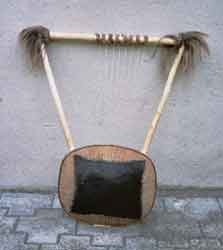
|
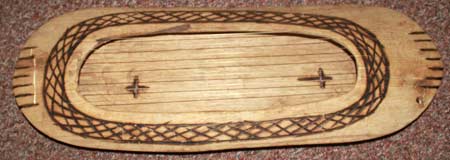
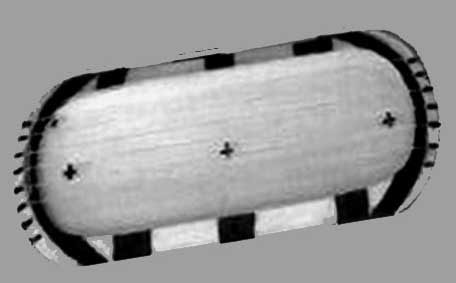
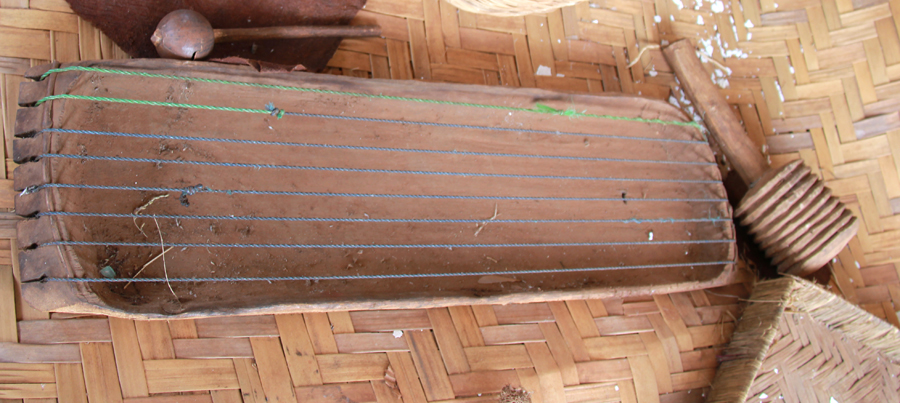
|
- Ennanga - Nanga
wooden zither - string instrument
This instrument was brought to Uganda by the Hamites and is common among the Bakiga and Acholi tribes. This string instruments emphasize the narrative and story-telling tradition of the people. Love songs, praise songs, epics, dirge songs and humorous songs.
African zithers have a boat-shaped sound box with a fairly long wooden neck, which enters the resonator. Ancient painting depict these instruments, often in the hands of women.
The ennanga is strictly a solo instrument and has eight strings, which run above a wooden trough. A zither is an instrument in which the strings run parallel to the resonator, which extends the entire length of the strings.
|
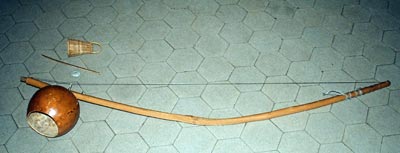

|
- Sekitulege - Berimbeau
musical bow - string isntrument
The musical bow is the simplest form of a string instrument and is thought to have been developed from the hunting bow made to shoot arrows. It is the mother of all string instruments, or at least of the harp, and it dates back to very early times.
This version is popular among the Buganda, Busoga, and in the western Nile region. It has only one string, which changes pitch depending on the tension of the bow. The sound-box made from a gourd.
Aunene - ground bow by the Iteso people.
|
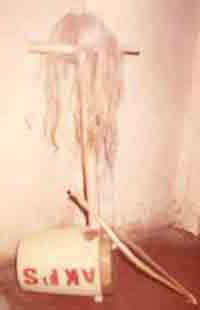
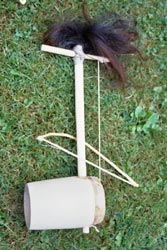
|
- Endingidi - Adigirgi
tube fiddle - one-string-fiddle - string instrument
This instrument is popular in the Buganda, Busoga, Ankole, Kigezi, western Nile, and Acholi regions. It consists of a single string, which is attached to a flexible stick and will sometimes have a resonator. Unlike other single-string instruments, it is played with a bow.
This tube fiddle is variously called also endingire, akadingidi, endingidi, esiriri or shilili in the different Bantu dialects; and it is called arigirigi, rigirigi by the non-Bantu tribes. This instrument takes its name from the blowing action and the kind of sound that the instrument produces. The instrument is played to enunciate words or phrases as if a parrot simulates the human language. It is essentially a solo instrument with voice but it can also be played as duo, trio or together with other instruments.
|
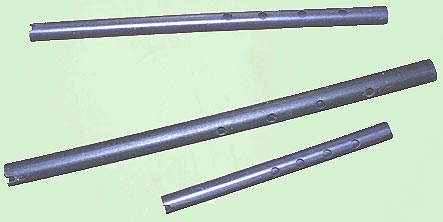
|
- Endere
flute - wind instrument
The flute is widely popular in all regions of Uganda with five fingerholes. It is played both as a solo and accompaniment instrument.
The endere of the Baganda people, the omukuri of the Banyankore and the Bakiga people, the akalere of the Basoga and the alamaru of the Iteso people are similar in their production as well as use. The instrument is blown at the slightly V-shaped slit end of the instrument, usually with four finger holes. In Ankole (Nkole) the instrument is also played at times in order to be accompanied by drums. If the instruments are not played to accompany dancing, the people use them to play smooth melodies for the grazing cattle or to interpret love songs. In Buganda it can be played solo, in a duet or in small ensembles. An ensemble consists of the largest flute (kiwuwa), the middle (enkoloozi); the third largest (entengezi); and the smallest one (entengo). In the Busoga region it is a dominant instrument and it is played in combination with other wind or percussion instruments. The Iteso people use this flute mostly solo, or they accompany it with an akogo (finger piano).
|
|
|
- Enkwanzi
panpipe - wind instrument
The enkwanzi or oburere is a panpipe that comes from the Busoga region and is made from elephant grass or bamboo. They are stopped flutes, meaning that the node of the plant stops the hollow tube and thus determines the pitch of the pipe. The tubes are arranged from lowest to highest and laced together with string. The open rim at the top of each tube is cut at a right angle to the tube so that the player may blow across the top, like blowing across a bottle.
This panpipe has at least five pipes. The melodic possibilities of the panpipe and other sets of flutes perhaps influenced the development of flutes with fingerholes.
Instruments, which produce sound through a vibrating column of air, are called aerophones. In flutes the player directs a stream of air over the sharp rim of an open embouchure hole in the side or on the top of the pipe.
|
|
- Oseke
detached flute - wind instrument
This instrument comes from the Alur tribe of the western Nile region. The technique for playing it is similar to that of the agwara (the side-blown horn). Also used for coaxing wild animals.
Instruments, which produce sound through a vibrating column of air, are called aerophones. Horns are a type of "brass" or buzzed-lip instruments.
|

|
- Amakondeere - Engombe - Enzambe
horn - wooden trumpet - wind instrument
These instruments are found throughout Uganda, and they are believed to have come from the Bushmen and Hamites. The use of wooden trumpets is closely linked to ancestor cult and adolescent initiation rites.
These instruments are made from various materials. High-pitched trumpets are made of antelope horn. Medium-register trumpets are hollowed out from tree roots. These instruments have a mouth-hole cut at a slant, so that the instrument is played in a transverse position.
Low-pitched instruments are sometimes cut from the trunks of the papaw tree and are blown in a straight position through a mouth-hole at the end. In an ensemble of these instruments, each player sounds his single pitch in a rhythmic pattern defined within a very precise metrical framework. The very close interlocking of the individual trumpets within that framework performed at a fast tempo.
The amakondeere of the Baganda, Banyoro and Batooro people, the amagwala of the Basoga people and the agwara from the western Nile region (the Lugbara and Kebu people) are long horns (sounds similar to trumpets) made of carved wooden frames which are larger at one end and have a hole to blow through. These instruments are played in sets. They are covered with cow skin to give them a beautiful finish of different colours. All these sets are, in general, royal instruments. In Buganda, Bunyoro and Batooro they were used in the royal palace for ceremonies like crowning and wedding festivities of the kings, such as their anniversaries and burials. In the western Nile region the set was used when celebrating the new chiefs and in all other great gathering occasions.
Instruments, which produce sound through a vibrating column of air, are called aerophones. Horns are a type of "brass" or buzzed-lip instruments.
|
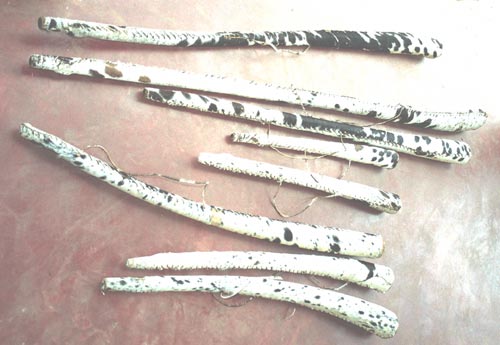 |
- Agwara
side blown horn - wind instrument
These come from the Lugbara and Kebu tribes of the western Nile region and are played in groups of seven or more. These side-blown horns sometimes have a single fingerhole, which is used for grace-note ornaments.
The instruments of the Iteso and Karimojong people are made of cow horns and have only one mouthpiece; they are only used for communicating or giving signals.
Instruments, which produce sound through a vibrating column of air, are called aerophones. Horns are a type of "brass" or buzzed-lip instruments.
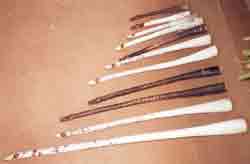 |
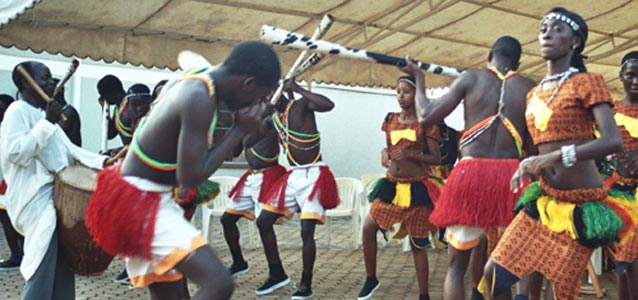
|
|
- Akadinda - Embaire - Entaara - Amadinda
xylophone - percussion instrument
The wooden keys of the various xylophones of the region can be resonated in various ways to amplify the tones. Resonators may take the form of small hollow objects beneath each key, a common sound box for all keys, or even a pit dug into the ground. In this last form, the keys lie parallel to one another over and across the pit, which is about 70 centimeters deep and almost two meters wide. The musician strikes the left-hand keys (the bass) with a mallet of fairly soft wood and the right-hand keys with a heavy crooked mallet made of extremely hard wood. The keys of a smaller version of this xylophone are set above a shallower pit. This smaller xylophone provides melodic and rhythmic ostinatos as a cue for the larger main xylophone, which plays different themes designed to persuade deities to dance at the ceremonies for the vodun (voodoo). A pair of rattles and an iron bell always complete a performance on this double xylophone, and the performance is often accompanied by song.
The xylophone is a very popular instrument in the Bantu region. The keys are separated by either long sticks (among the Baganda people) or short ones and are placed on banana stems. The Bakonzo and Basoga use both short and long sticks. The keys are tied in place by threading a string through small holes in the wood.
The amadinda has two "shoulders" carved on the bottom so that the keys, which are not otherwise fixed, will not move when placed on the banana stems. Nowadays the entire instrument is made out of wood.
The amadinda and akadinda vary in size and number of keys, though both are tuned in an equidistant pentatonic scale. The amadinda has larger keys. In earlier times, the amadinda had up to 22 keys. Five men are needed to play the 17-key version and six the 22-key version. The larger instrument is now rare and is played for the Kabaka (the king of the Baganda). Today the akadinda can have between 10 and 20 keys, and the amadinda has 12 keys played by three men. One performer plays only the two highest notes while the other two play different melodies on any of the remaining ten. These melodies are often abstractions of vocal pieces adapted for the xylophone. The interaction of the two players' melodies (each playing in octaves) creates a third melody with a longer metric cycle. Through this interlocking technique, two players can play a single melody at a very fast tempo seemingly without breaking a sweat. The compositional structure of pieces played by both instruments is essentially the same, except that the 20-key amadinda is played by four performers and the 10-key version by a soloist (in conjunction with (the Mbaga) wedding dance, for example).
Instruments, which produce sounds through the vibration of their whole bodies, are known as idiophones.
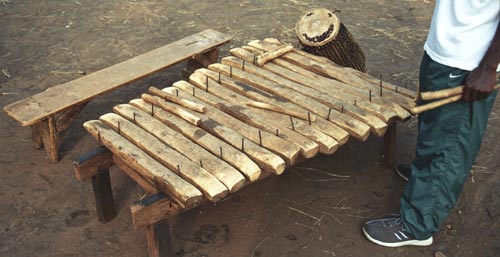
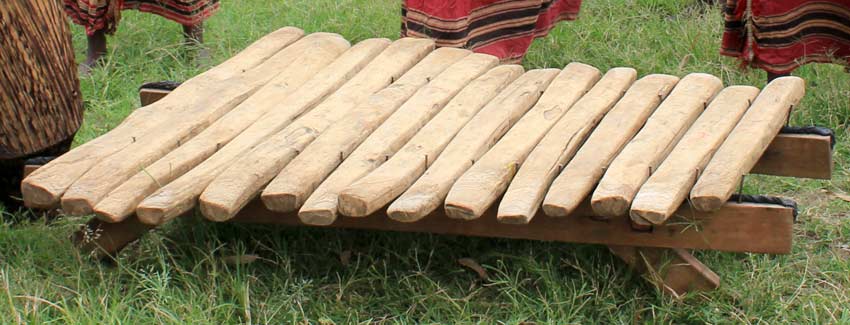
|
Amadinda
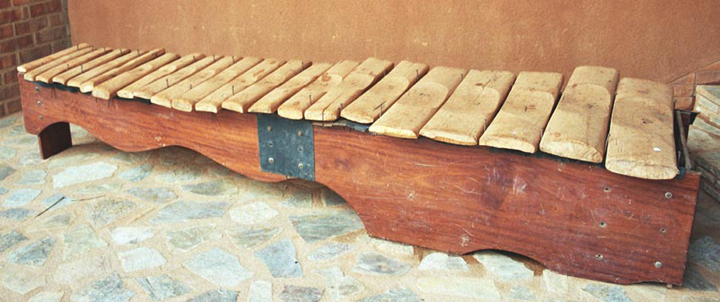
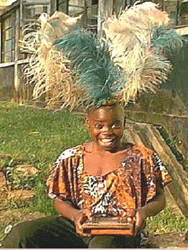
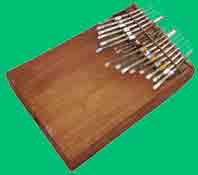 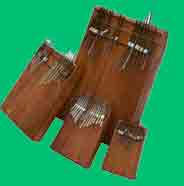
|
Akogo - Likende - Akadongo - Sansa - Mbira - Akalimba
thumb piano - percussion instrument
Many different names exist for this instrument; kalimba, sansa, and mbira are the most common ones. It consists of a series of flexible metal or cane tongues of varying lengths fixed to a wooden plate or trapezoidal sound box. Nowadays the resonator is made of kiaat wood, and the tines are made of high-quality spring steel. The musician holds the instrument in both hands and uses his thumbs to pluck the slightly upturned free end of the tines. The number and arrangement of the tines, or lameliae, vary regionally. In Uganda the instrument is usually played solo, perhaps to relieve a traveler's solitary trek or a night caretaker's long watch. The instrument accompanies a repertoire of "songs for thought," or laments, sung by both men and women.
In Buganda the instrument is known as "akadongo kabaluru" or "little instrument of the Alur tribe" from the northwest Nile region. The Mbuti pygmies in Amba use rattan cane keys and a straight bridge. However, most sansas in Uganda have metal keys and a U-shaped bridge. The Basoga tribe plays different styles of sansa altogether.
Sansas today are usually tuned to the diatonic scale of G major, although they can be retuned to any key.
Instruments, which produce sounds through the vibration of their whole bodies, are known as idiophones.
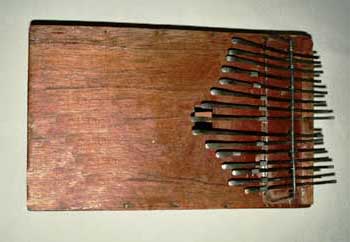
|
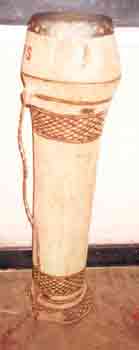  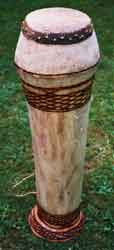
|
- Engalabi
long drum - percussion instrument
This traditional drum has a head made of reptile skin nailed to a wooden sound body. The engalabi from the Buganda region has an important roles in ceremonies and in theater. It is called "Okwabya olumbe". This is the installation of a successor to the deceased, thus the saying in Luganda (in Buganda a Bantu dialect) "Tugenda mungalabi", meaning we are going to the engalabi, that is, long drum.
Rule in playing the drum is the use of bare hands.
Instruments, which produce sound through the vibration of a stretched membrane or skin, are called membranophones. Drums come in a variety of shapes.
|
|
- Engoma
- Uganda drumset - percussion instrument
While larger versions of this drum are traditionally hand-carved from old-growth hardwood trees, now these drums are made with pinewood slats tied together like barrels. Smaller drums are laminated and turned on a lathe and may be provided with a rope carrying the handle. All these drums have heads made from hide held by hardwood pegs hammered into the side of the drum.
Drums in African tradition bring the power that drives a performance. Music is not merely entertainment, but is ultimately bound to visual and dramatic arts as well as the larger fabric of life. Drums may be used for "talking," that is, sending information and signals by imitating speech. Many African languages are both tonal (that is, meaning can depend on pitch inflections) and rhythmic (that is, accents may be durational), giving speech a musical quality that may be imitated by drums and other instruments. Drumming music and dance are almost always an accompaniment for any manner of ceremony; birth, marriages, funerals.
|
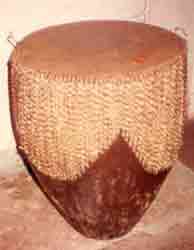
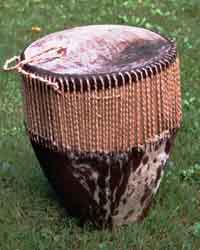
|
- Embuutu - big drum - percussion instrument
|
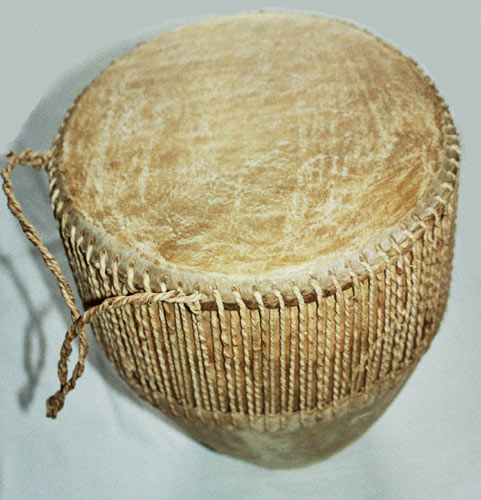
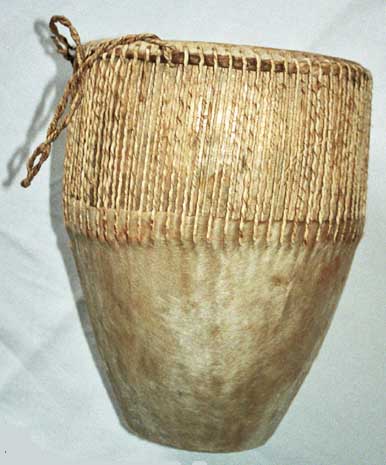
|
- Namunjoloba small drum - percussion instrument
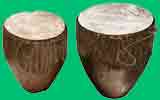
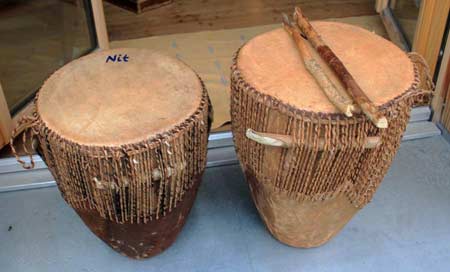
|
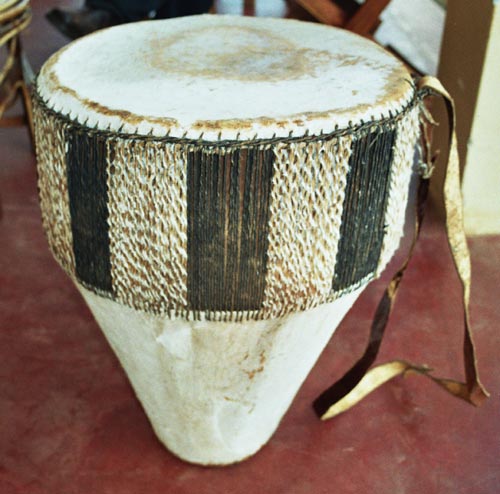 |
- Akaduumi - percussion instrument |
- Empuunyi - bass drum - percussion instrument
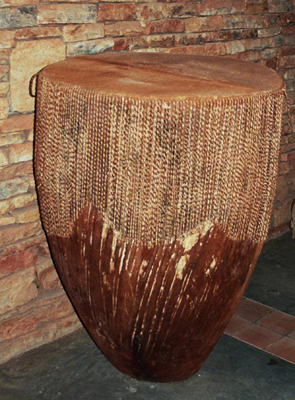 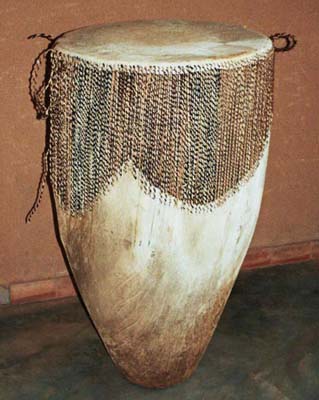
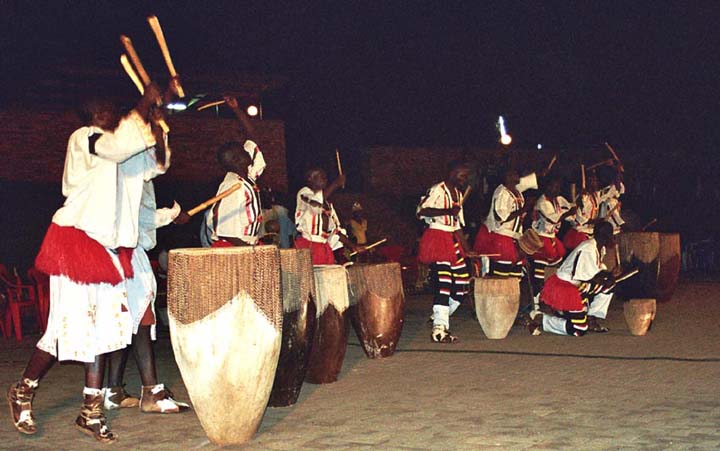
Omuguddo (Original from Rwanda)
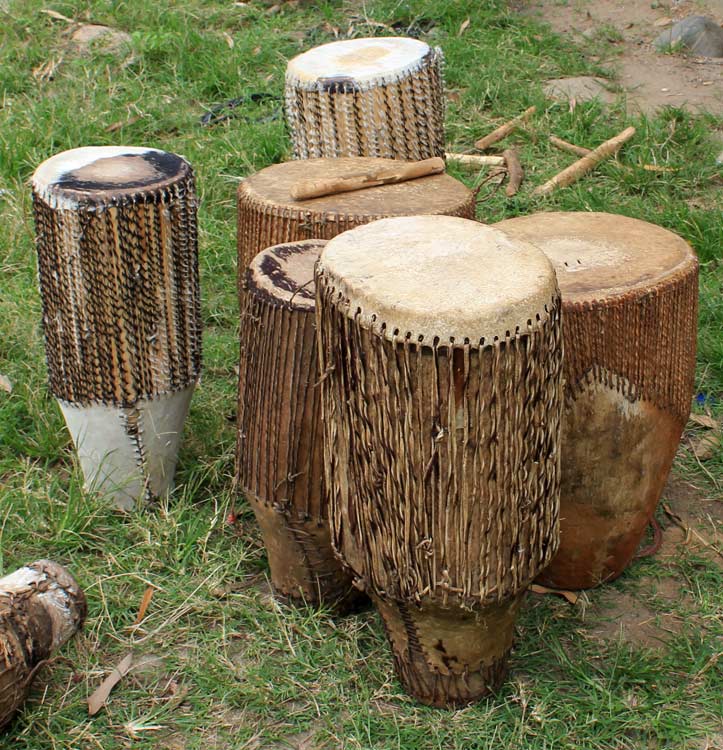
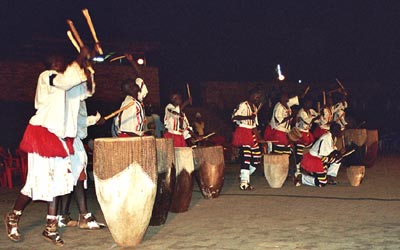 |
- Entenga - Namandu
drum chimes - drum set - percussion instrument
|
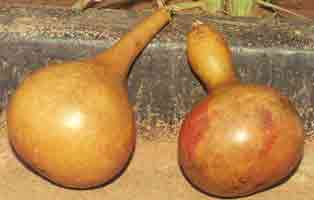
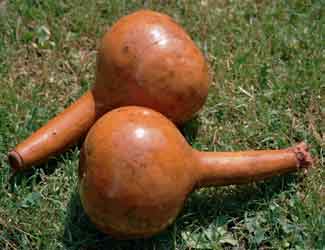
|
- Ensaasi- Enseege
shakers - percussion instrument
Shakers are made in pairs from gourds or shells, sometimes with stick handles, and are used to accompany other traditional instruments in Uganda. The central and northern (Alpaa) regions have shakers that produce a continuous sound as beads move from side to side in the gourd or shell. Generally, these shakers produce sounds by many small objects, such as pebbles, rattling together inside the body.
Instruments, which produce sounds through the vibration of their whole bodies, are known as idiophones.
|
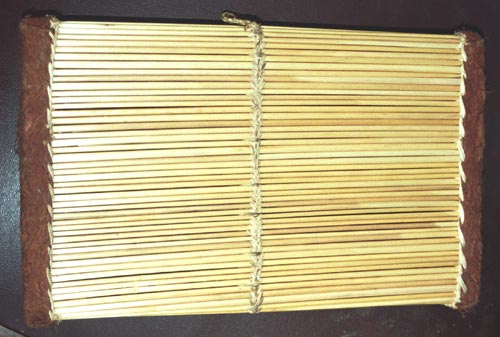
|
- Akacence - shakers - percussion instrument
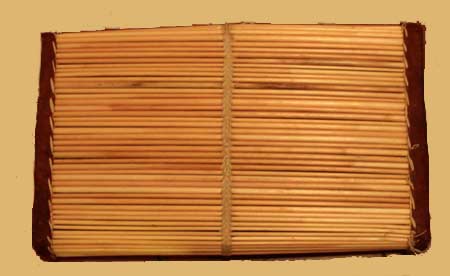
|
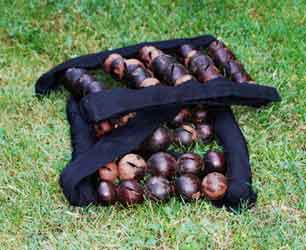
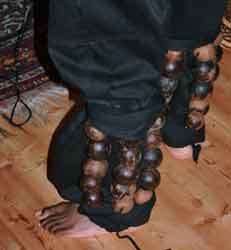
|
- Ebinyege - Binyege (Entongoro)
- rattles - percussion instrument
These originate in Bunyoro and Batooro (Toro) in Western Uganda along the roots of mountain Rwenzori. The seeds are put in these dry fruits to produce rhythmic patterns when shaken. Ebinyege are tied on the males legs to produce the sound and the Runyege dance (courtship dance of the Batooro) is named after the ebinyege, hence an important prop.
Oncoba spinosa - Snuff-box Tree - Fried Egg Tree
- Oncoba spinosa: belongs to the species of Oncoba and means ‘prickly’. This term is in general used for this type of ornamental and fruit plant.
This is a small thorny bush or deciduous tree of medium height, which may reach a height of up to 5 m. The tree may even reach a height of 8 m. The bark is flecked with grey and rather smooth. The young twists are extraordinarily speckled, having slightly lifted, lens-shaped areas. The thorns are straight and have a length of up to 50 mm. The leaves are simple, egg-shaped and elliptical, a little bit pointed and levelled-off; they are furthermore dark-green, shining, a little bit leather-like and without any hair. The snuff-box trees have beautiful white-yellow camellia blooms, smelling like honey and being individually arranged. The white-yellow blooms look like “fried eggs”, which gives them their name. The flowers bloom from early spring until summer. The fruits thereof have a sour but edible pulp of flesh. The diameter is up to 60 mm, and they have a hard shell, which becomes dark red brown when it is ripe. Inside there are embedded shiny brown seeds in a dry, sour and yellowish pulp. The hard shell of the fruits is in Uganda used as a snuff box or in the dried condition as such rattles. Dried fruits having seeds inside produce such a rattling sound. They are further used as ankle bonds or bracelets in order to generate a rhythmic pattern.
The pulp is edible, but is only seldomly used for this purpose. In African medicine, the roots are used for treating dysentery or bladder problems. The seeds further contain oil that is suitable for drying lacquer.
This tree is rather common alongside the Eastern side of Africa down to South Africa, mainly in dry woods or open savannahs, in river valleys, on rocky hills. The northern-most frontier is the Eastern side of the Red Sea in Saudi Arabia.
|
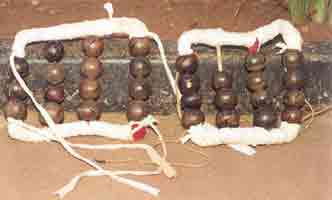

|
- Endege
ankle bells - percussion instrument
Dancers frequently have metal jingles tied on their ankles to articulate their movements.
|
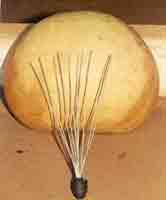 |
- Agwata
- percussion gourds - percussion instrument |
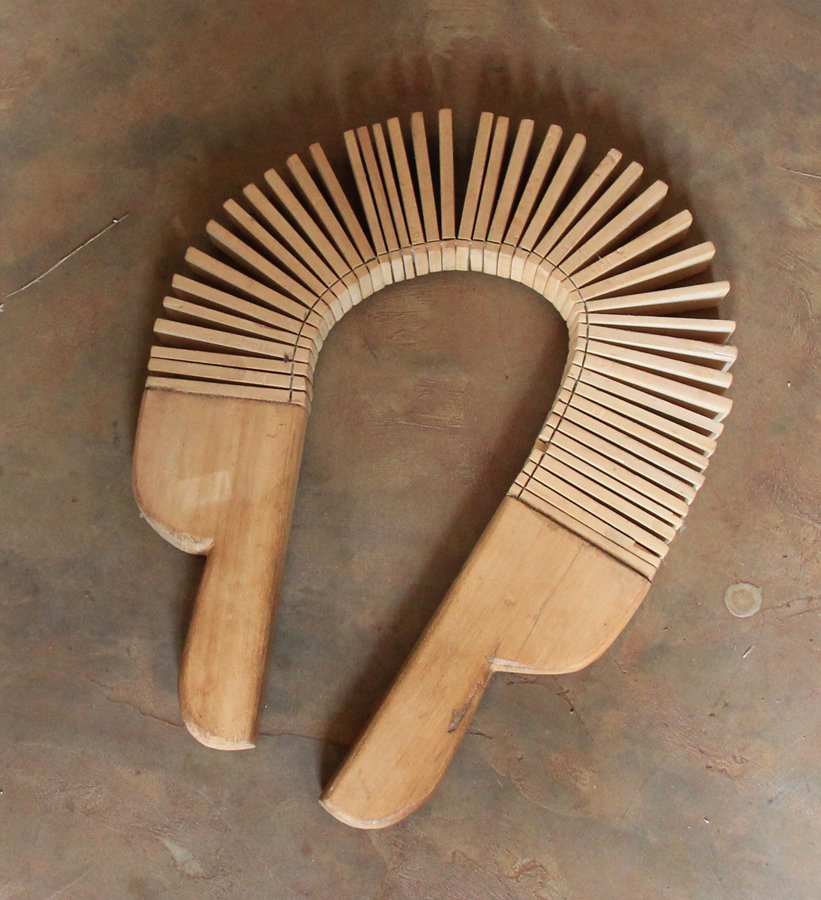 |
Rattle - percussion instrument |
| |
back to the Index – Projects Uganda
|
PageTop
 |
Revised by Hermelinde Steiner |
|
